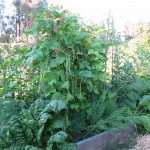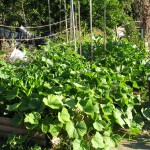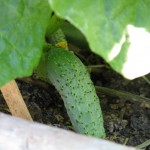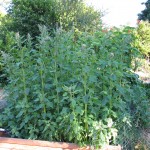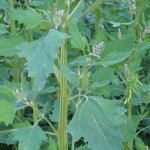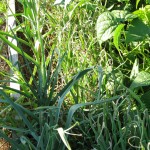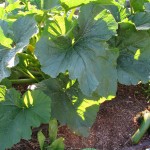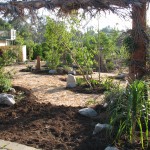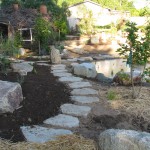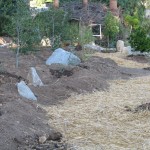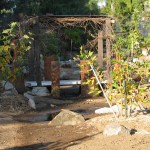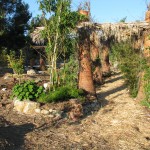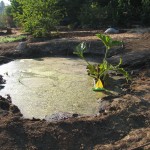-
The Importance of Leaving a Mess

Animal tunnels through a brush pile A clean yard is usually a pleasing sight. Picking up loose boards, plywood, sticks and logs keeps people from tripping, is encouraged by the fire department to reduce fuel for fires, and makes for more room to walk. Also, things live under debris and we’ve always been told to not poke our fingers into dark places (excellent advice! If a giant stuck his huge finger into our bedroom window we’d try to hurt it to make it go away, too!), and by eliminating so-called debris we reduce the chance of bites by snakes, spiders, or whatever bitey things may be living in your part of the world.
However, by reducing the debris, we also reduce habitat. Those bitey creatures need a place to live, as do the non-bitey creatures we are also displacing by removing wood. All these creatures are part of the intensely woven food web that keeps our planet populated and working. I cannot disagree about making your yard safe for children and pets, but if you have a space, make an area for habitat, too. Rope off a corner of your yard and tell your children and pets not to go into there, and leave bundles of sticks, pieces of plywood, old logs, piles of leaves, etc. in that corner. This is a home for the wild things, and your children can understand, observe and respect the fact that the world should not be made clean for them. Teach your children not to hunt and catch wild things, not to tear apart nests and destroy habitat. Observe and wonder instead.
In my yard, especially since I’ve had some sheds removed (in which racoons, wasps and possums raised families… I’m hoping to make a new place for them), I have stacks of plywood and old buidling materials which are good for recycling back into projects around my house. A junkheap, yes; a goldmine, yep. Under these stacks I have found such wonderful creatures that I didn’t even know came into my yard (perhaps they didn’t until the wood was left out).
The most exciting creature was a female Western pond turtle.

Female Western Pond Turtle In Washington, the Western pond turtles are endangered, and they are considered threatened in Oregon and are becoming rare in California and Baja California. Besides loss of habitat and an increase in pollution, one of the major factors in our native turtle’s slow demise is the release of non-native aggressive species such as the red-eared slider turtles. Red-eared sliders are America’s favorite pet turtle although they are native to the Southern United States. Due to releases they are everywhere. DO NOT RELEASE YOUR PET INTO THE WILD! As much harm has been done by and to domestic animals and wild animals by the releasing of pets as by habitat loss. A number of years ago there was a salmonella scare allegedly traced to pet turtles. The public’s response was to dump their children’s turtles in any waterway close by. Red-eared sliders have a distinctive red line by their eyes, and are named sliders because that family of semi-aquatic turtle can slide into the water quickly. They are omnivorous, aggressive, adaptable and become large. They eat anything that they can fit into their mouths, including the less aggressive smaller Western pond turtles.

Females have flat plasterons; notice her left stumpy leg. Finding a female Western pond turtle in the yard was fantastic, and I can only surmise that she had made her way up from the shallow streambed below the property to hopefully lay eggs. I haven’t found signs of a disturbed area yet where she may have layed, but am keeping the whole area protected just in case.

Long tails She is missing one front foot, probably bitten off while a youngster when something was trying to eat her. Before we knew she was a she, we thought of giving him a piratey name due to the missing foot and her semi-aquatic nature. Captain Blood was too fierce, but the author of that and other swashbuckling tales which had been made into movies is Raphael Sabatini. Now that is a terrific name. Go ahead and say it to yourself. See? So he became Raphael Sabatini until we checked her plasteron (the underside of her shell) and realized that it was flat not concave, which meant that she was a female. Males need concave plasterons so that when they are, um, amorous, they don’t fall off so easily. So she became Mrs. Sabatini. Long story… sorry. Nothing simple in my life. Anyway, we checked out Mrs. Sabatini’s health, and then released her into our small upper pond, which has an excess of mosquito fish and bugs, so that she wouldn’t be hurt with all the work that is being done down where she was found. We haven’t seen her since, so hopefully she is healthy and happy.

Good-bye Mrs. Sabatini! Under another piece of plywood I’ve found blue-tailed skinks (I couldn’t take a photo because they move too quickly), California Slender Salamanders,

California Slender Salamander gopher snakes, king snakes,

California Kingsnake and Pacific chorus frogs.
In a brush pile there are many birds hopping through, especially California towhees, Western fence lizards, alligator lizards, tree rats, mice and many other creatures.
In the ground are insects that you’d never expect. For instance while weeding one of my heirloom bulb beds I disturbed this huge caterpiller that had a horn tail.

White-lined Sphinx Moth Caterpiller The only horn tails that I’m familiar with are the tomato hornworms, but this guy was far away from my veggie patch, and instead of stripes had spots. We looked him up, and he is the caterpiller form of the White-Lined Sphinx Moth, also known as the hummingbird moth because of the way it hovers in front of night-blooming flowers to drink nectar. It is one of the important nighttime pollinators which few ever see. We put him back and left some weeds in for him.
Of course mason bees, among other pollinators, use holes in wood in which to nest. Some bumblebees nest in abandoned gopher holes, and they are the natural pollinators of many native North American plants such as blueberries (honeybees were imported from Europe with white settlers; until then native plants developed their flowers to attract and accomidate bumblebees, wasps, and hundreds of other native insects.)
All around my property there are logs and brush piles, and plywood layed down to choke out weeds in my veggie garden. Underneath there is a world of habitat. Isolated refuges for animals and insects who desperately need places to feel safe. So go ahead, throw down some mulch, some logs, a pile of sticks or some plywood. Know that you are doing the Earth a favor.
- Gardening adventures, Permaculture and Edible Forest Gardening Adventures, Ponds, Rain Catching, Vegetables
Yesterday in the Garden
Yesterday was the solstice, the formal beginning of summer. The longest day of the year. (Only six months to Christmas!) With months of growing season already behind us here in San Diego County, and the threat of drought and fire ahead of us, it is a time to enjoy the bounty that we already have. This is my year for gardening: I have the best vegetable garden I’ve ever had, after years of building raised beds and lining with aviary wire against gophers, improving the soil with compost, and buying organic seeds and fertilizers. I also have incredible freedom in my yard to plant whatever I like, wherever I like (within the constraints of tolerance by the plants). I’ve always had to cluster plants around where I’ve slapped together irrigation on the few stolen weekend hours I could devote to my yard. No more! With the permaculture gardens, the well and the drip irrigation, I am excited about my yard for the first time in the twelve years I’ve lived here. With the incredible job that Roger Boddaert and his team of Juan and Francisco, and also Aquascape’s Aart DeVos with his manager Jacob who has spent thirteen hour days on my property and is back early the next morning, the permaculture project is nearing completion and is spectacular. As a habitat it is succeeding, attracting more wildlife every day. As a food forest it has is off to a good start, with extra going to go to the Fallbrook Food Pantry. As an interesting, decorative garden it is unique and full of surprises. I’ll show you some photos; you can click on any of them to enlarge, but it will open in this window and you’ll have to use the back arrow to return to this page:
Long Scarlet Runner Beans Vigorous vines Little pickling cucumber Towering Quinoa Seeds on multiple stems Garlic Nearing Harvest Time First zucchini harvest Through the main entranceway Streamside walkway Mulched beds with swales Tin-roofed bridge The Palm Aisle My First Yacht Yarrow between the stepping stones -
Cob Oven, Part One

Levelling the firebricks Today six members of the San Diego Permaculture Group converged upon my property to build a cob oven. No, not with corn cobs. Cob is an ancient building method that is similar to adobe, but without the brick. Cob buildings, some of them several stories high, have stood for centuries in as diverse areas as Turkey and Wales. Building a cob outdoor baking oven is a good exercise in cob building that is useful and easy. None of the members, nor my daughter who jumped right in to help mix mud, had made a cob oven before. That was okay, because neither had I! Using as a reference the book Build Your Own Earth Oven by Kiko Denzer, and having watched several YouTube cob oven videos, we set off on our learning experience with the energy and fellowship that this newly formed group radiates.
Because of all the deconstruction on my property, building materials were at hand. I decided to set the oven on a cement platform left from a torn-down shed. That eliminated digging and filling a drainage base. My son had helped carry bags of sand down to the work area, which besides straw and wood shavings were the only items I purchased for this project. With broken concrete and cinderblocks, the group made a circular base about two and a half feet high.

The base made with cinderblock and cement chunks The height helps the back of the baker, but if the oven isn’t used all day every day, a shorter one isn’t going to be a problem. Especially for a short person like myself. Not that short, but short.
When I moved onto the property there was all this gravel and stone around. I hated it. I removed a lot, but much disappeared into the pathways. Some has resurfaced with the tilling that has been done to loosen the soil and add mulch. We gathered a lot of the stone along with some dirt and used it to fill the base.
Then we made some rough cob. There was a pile of hard clay that came from the pond excavation. In fact, the bottom of the pond, which is unlined because of the clay content, is almost pudding-like in consistancy with the silky clay. How do I know? Well, let’s say that on a hot day this last week I got to know my pond a little better.

Collecting clay samples with my feet Anyway, the clay contains really hard lumps. It will make wonderfully strong cob, but first it has to be broken down. My daughter filled a wheelbarrow with it, then we dumped it out onto a tarp and added water, expecting it to be easy to mix when wet. Wrong!
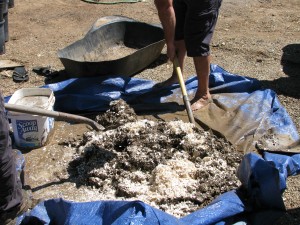
This insulation batch is made with clay, sand and wood shavings We added a lot of water and some sand, and mixed pretty well, then added some wood shavings to it for tensile strength. This was used to gap holes in the oven stand and form a base for the insulation. The insulation was made of the flat vodka bottles somebody in the history of this property obviously preferred, along with a broken necked Coke bottle that were found when the pond was excavated. Pretty cool, huh?
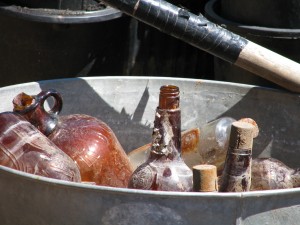
A treasure of old bottles 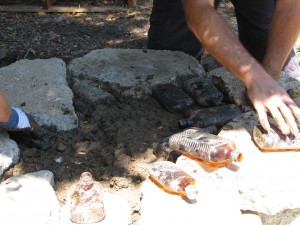
Bottles were layed on cob for insulation Meanwhile, another wheelbarrow was filled with clay and water, and a group started using their hands to mix it and disintigrate the hard lumps if possible. This took a long time, and still there were lumps. The scene looked like the part in Moby Dick when the whalers are kneeding the blubber with their hands, only a lot less gruesome. This clay mix must be smooth for the next step, building the oven itself.
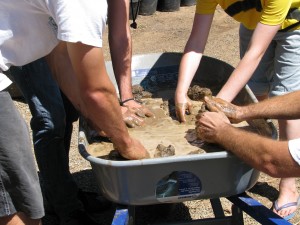
Finding the lumps in the clay On top of the bottles went a layer of sand, which was levelled as best we could. On top of that went firebricks, which were also levelled.
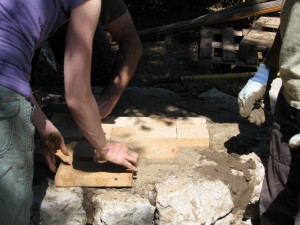
The firebrick was layed on sand At this point we stopped due to time. The whole process was only a little over two hours long. The wheelbarrow of prepared mud has been covered, as has the oven base. In the very near future we plan to reconvene and make the rest of the oven. After that… pizza!
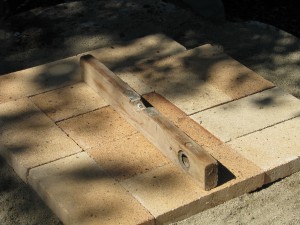
Everything was even except the middle -
Answers

Drinking the Small Pond Down I really haven’t been avoiding blogging. I’ve tried to do it, but I’ve just been exhausted in the evening, which is my usual writing time, and haven’t stayed awake long enough to finish writing. Obviously we’ve made it back to Fallbrook, pulling in about 9 pm on Saturday. Many things happened during my five days gone. As I am about to frost a Buttermilk Chocolate Ganache Cake (see recipes!) (I occasionally sell baked goods) that will be picked up at 7 am tomorrow, I’ll provide answers to the questions I posed before leaving on my Oregon Or Bust sojourn.
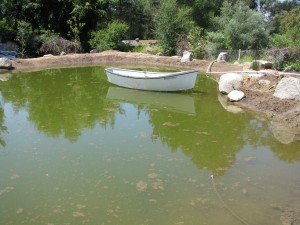
A Full Pond! Yes, the pond was filled! Gloriously full, and with a boat blowing from shore to shore in the breeze! The boat is on loan from Aquascape, who uses it in their work, but put out to float just to show off the pond for my return. Water plants are being transplanted and seeded around the ‘wicking’ areas, and the streambed area for rain is being sculpted. I’m not the only one who enjoys the pond!
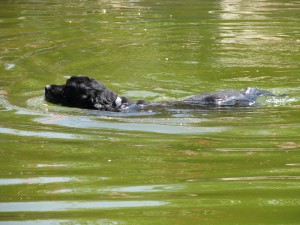
If he thinks he can sleep on the couch after this....! The palm trunks are being made into a bridge, which isn’t quite finished yet.

Bridge to Be The cement stairs now have posts for a walk-through arbor.

Gateway to the Garden The gnawed-upon palm stairs are even more gnawed-upon, but there are piles of bunny poo left where the culprits spent plenty of time wearing down their ever-growing teeth! The Bitter Apple didn’t seem to make a difference when I sprayed it on the steps. I’ll need to try garlic next.

Bunny Poo As for my veggie garden, the pumpkin and watermelon have grown at least two feet in a week, and the pickling cucumbers have outgrown the two lengths of support twine that I put up above their heads just before leaving!
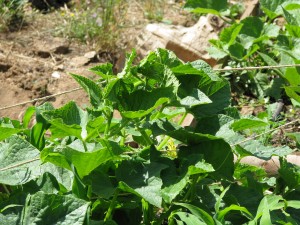
Vigorous Cukes I’ve added more and guided them up. All the plants not only survived, but they thrived. I so cannot wait for the taste of my own first of the season tomato!
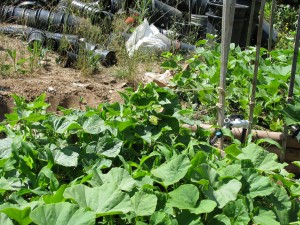
Happy Vines I still have a question, though. Why is it that a roadside stand in Oregon sells avocados for .35 cents apiece, when back home – in the Avocado Capital of the US – they sell for $1.45 apiece in the grocery store? And they aren’t very nice, either! You can’t grow avos in Oregon, or at least in that wet and cold part of it.
Not all the irrigation has been buried, but a good deal has. The sunflower will not raise it’s head again. The pond is slightly green, but picturesque and natural-looking; I don’t want an unnaturally clear pond. So all in all, a great week!
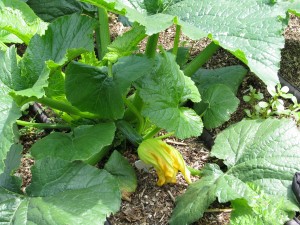
The First Zucchini... uh-oh! 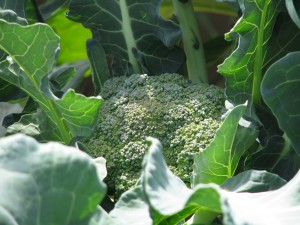
A Hidden Broccoli Head - Bees, Gardening adventures, Grains, Permaculture and Edible Forest Gardening Adventures, Ponds, Vegetables
What’s Happening in the Veggie Beds
“When planting seeds plant four in a row: one for the mouse, one for the crow, one to rot and one to grow.” (unknown).
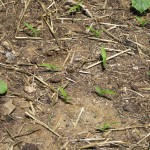
Baby Baby Corn I know what you’re thinking; you’re thinking, “Oh, no! Not more about peas again!” Well, yes, a little more about peas. It was time for them to go. I grew most of them from old seed just to use it up and to set nitrogen in the soil, since they are legumes. Some plants even had powdery mildew on them, which surprised me.
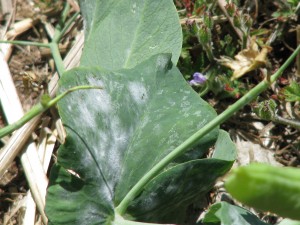
Powdery mildew I had to cut the plants off at the roots instead of doing it the easy way and pulling up the whole plants.
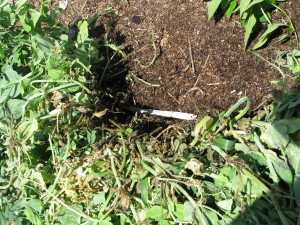
Cutting peas at their roots Since I’d hurt my right wrist a few weeks ago and I still haven’t allowed it to heal enough, the cutting wasn’t a fun job. It was worth it, though. I left the roots with their nitrogen-fixing nodules in the ground where they would do the most good.
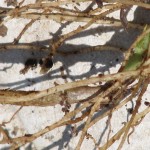
Peas set nitrogen in their roots Then I took all the pea vines up to the driveway, set up a chair, put on shorts and stuck my pale legs in the sun, plugged in an audiobook, and spent about an hour and a half tearing pea pods off of all the vines.
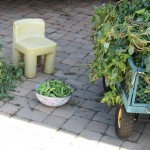
Harvesting time That night after dinner I began sorting through the pods and shelling them. I’m still not done.

Pea harvest I managed about half a big bowl of peas, which I sleepily shoved into the refrigerator before stumbling up to bed. My son was very calm in the morning when he told me about his surprise when he went for a midnight snack and spent about half an hour gathering up peas from the floor and adjacent rooms. I worked on more peas tonight. I’ve already frozen a couple of bags for our use; the rest will be frozen and used to feed the tortoises and chickens. All those pods and vines will combine with trash cans full of weeds I’ve been pulling along with kitchen trash to reconstruct my compost pile.
But there is life beyond peas. There are beans! I’ve planted several types of beans this year. Fresh green beans as well as soup beans and pinto beans. I’ve created two new raised beds and set them off from the rest of the garden. In them I’ve planted sugar baby watermelon, green melon, sugar baby pumpkin, and butternut squash.
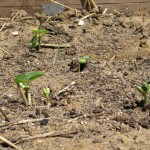
There's a pinto bean on the rise These vines will grow out rather than over other garden beds. In the middle of the beds I’ve planted pickling cucumbers, baby corn and pinto beans. They will all grow tall above the vines writhing and twining below. ( Hmm. Note to self: stay away from vine beds at night.)
Here’s an interesting piece of trivia: most gardeners have heard about ‘the three sisters’, which are the Native American pairing of corn, beans and squash. Actually, it should be four sisters, at least for Southwest Indians. The concept of the ‘sisters’ is that they form a complete plant ‘guild’. In other words, these three planted in combination produce more food than any one planted alone. The corn provides a trellis for the beans, the beans are a legume that fix nitrogen in the soil with nodules on their roots that feed off of sugars secreted by the corn roots (all this going on beneath your feet! Yikes!), and the squash forming a cooling, weed-suppressing ground cover that also deters raccoons (notorious corn-eaters who don’t like to walk through the vines). What is missing is a plant to attract and feed the pollinators. In the Southwest Anasazi settlements it was Rocky Mountain bee plant (Cleome serrulata), which has edible parts to it and fixes iron (the Anasazi used it as a dye plant as well as food). With an edible plant guild, we feed the soil and the pollinators as well as ourselves. You can read more about this in the fantastic book on permaculture by Toby Hemenway, Gaia’s Garden. An excerpt is right here: http://patternliteracy.com/the_three_sisters_or_is_it_fou I’m trying my fourth sister as dill weed, which is an excellent bee plant because of it’s small umbellate flowers. Dill also goes well as a flavoring for corn, cucumber and squash, and usually plants that complement each other taste-wise do well planted together, such as basil and tomatoes.
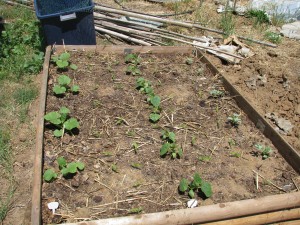
Cucumber, baby corn, watermelon and squash Speaking of which, my garlic/shallot/tomato and basil bed has taken off with the warmer weather. These are slicing tomatoes; I have planted Roma and a yellow variety in other beds.
Where the peas have come out, the broccoli, carrots, parsnips, lettuces, endive and cilantro are doing well. I’ve planted some small eggplant sprouts and more carrot seed so there is a continuous supply.
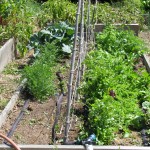
Life without pea plants Organic sweet corn will go into this bed, which will provide shade for the lettuces. Corn of different varieties must not come into silk simultaneously or they will cross-pollinate. The baby corn in the other bed will mature earlier by nature and by planting times. Those little corn ears can be eaten fresh or left to harden to be used for popcorn. The whole ear can be put into a microwave, for those of you who have such a newfangled contraption (I haven’t owned a microwave, um… ever!).
We’ve had new visitors to the garden. Besides my gopher snake friend (see my post Unsticking the Snake of May 14th), who has been seen again, and a longer gopher snake, my son and I saw a king snake whipping down a gopher hole in the lower Bee Garden, and then today this fellow came through the Chicken Tractor then through the Swiss chard and onion bed, and across the property.
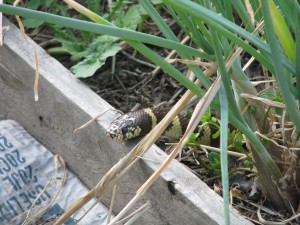
"So good to rest my weary head for a minute!" I’ve only seen one king snake in the yard who shows up in the height of summer to look for mice under the bird feeders. The standing water in the pond and the disturbance of the soil has attracted more of these friends, especially since my dogs are elderly and aren’t ‘making the rounds’ like they used to.
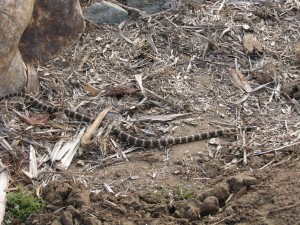
Banded kingsnake Kingsnakes are a little more tetchy than gopher snakes, and will eat other snakes including rattlesnakes. They can be striped or banded, even in the same clutch of eggs. Just like siblings with different hair colors.
Speaking of ponds, the standing water in the lower pond hasn’t receded very much, but has had an algae bloom.

Pea Soup Pond I’m going to have to have a well drilled on site, and have spoken with two well drillers and have received one bid, and am waiting for the third day for a call back. Honestly, is there so much work for some people in this economy that they can’t return phone calls or show up to appointments? During this gardening adventure of the last few months there have been several people of different occupations who just haven’t kept appointments or returned calls although they are still in business and initially shown interest. What’s up? Grrr.
The quinoa (pro: keen– wah) is doing well, and the potatoes are ready to harvest.
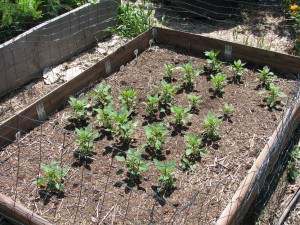
Quinoa rows Although I planted a whole packet of sunflower seeds throughout the property, only this blue jay-planted one in my strawberry bed came to anything. It looks like a puckered face!
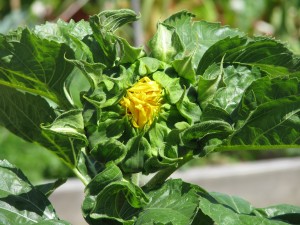
"Too much lemon!" -
A Scream in the Pond
I have a small lined pond in my front yard, created by my daughter and I a good five years ago or so. It is a pond gone native, for the most part, and I like it that way. The mysteries of what lives in those three feet of murky algae-laden water give me a shiver and excite my naturalist sense of curiosity (See post The Monster in the Pond of March 2nd). Sometime earlier this year as I was walking past the stretch of green that was partially covered with newly unfolding waterlily pads, I was startled from my reverie (I’m always in reverie it seems, especially now that I’m wrestling with mid-life crisis!) by what sounded like a small scream and a splash. I saw nothing. Hmm.
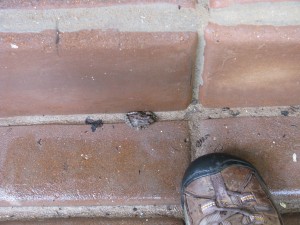
Young Pacific Chorus Frog During the most frigid, god-forsaken unpopular months of January and February, it seems as if every Pacific Chorus frog migrates from a forty-mile radius to mate in my small three-hundred gallon pond. Every night the males attempt to out-sing each other with such buzzes and chirps that even I’m impressed and tempted to follow their siren song, if only it weren’t so cold out there! (Wimpy San Diegan, I know!) Let their large ladies deal with them, I say. Sometimes their song is so loud that it becomes one giant noise. Often it drowns out whatever movie we might happen to be watching and we have to shine a flashlight out the window to startle them, catching them in flagranti as it were and quieting them for a short reprieve.

Pacific Chorus Frogs Taking a Break from Singing However, none of them scream. They sing.
When walking past the pond a few weeks later it happened again. A much louder scream and a splash. At least I knew that whatever it was hadn’t been so frightened by my passage that it committed suicide the first time. Then soon after my son came in from the front yard with a puzzled expression and said, “Something in the pond just screamed at me.”
There is a lot of algae in the pond which blooms about the time the frogs are mating, so I leave the frothy green bunches in place to protect the clear jelly sacks of spawn that cushion the frog eggs. Therefore, not much visibility at any time in my pond. Nope.
Finally I saw the screaming thing as it flung itself from the flagstones into the water. It was a large frog, much larger than the Pacific Chorus Frogs. Uh-oh.
When at breakfast I saw it sitting on the flagstone walkway around the pond through my bay window, my heart sank. It was a bullfrog. The glistening, beautiful green gigantic (for around here) frog sat there for awhile, then leaped into the undergrowth of my columbines.

Bullfrog about to go hunting through columbines American bullfrogs (Rana catesbeiana) are what you think of when and if you ever think of frogs. They can become huge. People farm them to eat their legs and back meat (oh ick!). Little American boys are supposed to spend their idle childhood summers wading through creeks (pro: criks) catching them and tickling their stomachs. I think they are a gorgeous and wonderful creature.
Except. Except that bullfrogs are not native to the Western states and they eat anything that they can shove into their mouths, including snakes, birds, rodents, other bullfrogs…. They are partially responsible, along with the red-eared slider turtles (America’s favorite pet turtle which was dumped wholesale into lakes and streams after the salmonella scare some twenty-five years ago and took over the waterways) and polluted water for endangering our native cute little Western pond turtles. So having this great screaming mouth eating down my mosquito fish, my Pacific Chorus frogs and their young, and everything else in the yard, is not good news in my book. Then my son noticed a second, smaller one. A male. Oh no!

Uh-oh. There's a male bullfrog, too! How to catch a bullfrog? I brought out an old cat litter bucket and a fish net and left them handy. We’d see the frog’s nose clearing the water, but by the time we’d go out there he would be long gone. Being very busy I didn’t have the opportunity to sit, net in hand, for hours waiting for my screaming frog to appear. (Hey, wait, shouldn’t that be ‘handsome prince’ instead of screaming frog? I get everything wrong!).
A few days ago on a sunny afternoon I was surveying the weeds in my garden, trying to burn them into cinders with my eyes without success. I walked along the pathway by the pond that was now almost completely overrun with peppermint, lazy stalks of columbine, the all-too vigorous Mexican primrose and the definately healthy weeds. I surveyed the back half of my garden making plans about weeding that had to be carefully done since many of the nasty little beggers were coming up in my heirloom bulb beds and their stalks looked almost identical.

Big Mama Wandering back I stepped through the overgrown columbine that hid the path when suddenly something big and shiny and screaming came flying up towards my knees from right under my foot. I also screamed and jumped. A second scream and leap to my left alerted me to the very large, very green bullfrog panting and staring at me with much the same expression that I must have been wearing as I stood staring and panting back. Even in my surprised state I realized that this might be my chance. Of course, the bucket was all the way over by the gate. I made a lunge for the frog but she evaded me. I managed to keep her from jumping into the pond and she disappeared under some weeds and mint by the bird bath. I squatted down and held down the grass hoping to contain her. I yelled for my son, but he was out of earshot. I started laughing, which I do so often in my life when I find myself in unusual circumstances. Come to think of it, I laugh pretty regularly. Maybe too regularly. Regaining control of the slight hysteria and my breathing, I slowly lifted up the grass… but she was gone. I knew she hadn’t jumped into the pond. She must have made her way along the sides of the flagstones. I made a plan. Quietly I stood and tip-toed around the back of the pond and around the end, making my way back toward the gate and the bucket with the fish net. Everything was still and I made no noise as I crept along. Just as I made it halfway past the pond, there were two almightly screams in close succession, two jumps and a splash. Fortunately it was the bullfrog who landed in the pond, not me. Shaking slightly with a trace of that hysterical laughter, I went inside to have a calming cuppa tea, and to give the lady frog time to settle her nerves as well. All that screaming had been a very girlie experience for both of us.
-
Water!

Upper pond and the Nest For the last two days we’ve experienced enough rain so that my permaculture adventures could be tested. Two storms, each bringing about half an inch of rain, created enough water for the watershed to begin to flow. Roger Boddaert and his team were busy rototilling urea into the areas which hadn’t yet been planted,

Freshly tilled areas soaked up water and Jacob from Aquascape and Jose were digging trenches for the drip irrigation system. They were very glad of the rain softening up the dirt!

Trenching for Irrigation Everyone was wet. Finally the rain gathered enough strength to flow down the street, under the fence from my wonderful neighbor’s property, and down the rain channel created by Jacob.

Water running in the trenches Some trenching had to be done to divert the water around the new Nest hut.

A diverting occupation Rapidly the upper rain catchment pond filled then overflowed down the rain channel into the second lower catchment pond.

Jose and I awaiting the overflow 
First Pond Filled 
Roger and Jacob ponding The scheme is that overflow from this pond will be channeled around the lower permanent pond and away so as not to overflow the big pond and erode the weakest and lowest end of the property around it.

Overflow water from the upper pond However since we were eager to see the big pond filled, Roger cut a trench from the second rain catchment pond to the big pond.

Overflow filling the second pond Earlier I had been in and out that morning on errands, and had settled in the house with a hot cup of tea and comfortable fuzzy pants on, when I realized that I was wasting water. I have three fifty-gallon rain barrels set around the house, which fill up within minutes and then overflow. Why wasn’t I channeling that water into the big pond? So of course I exchange my slippers for outdoor shoes (at least I did that!), put on a windbreaker with a hood, and go hauling hoses around to connect to the rainbarrels. I’ve had a sprained right wrist for a couple of weeks and pulling hoses was not the best medicine. So of course I did it, with my fuzzy pants wicking up rain and mud and beginning to drag under my feet. That’s me in a nutshell. Loving every minute of it. With three hoses leading down to the pond, all that wonderful roof runoff wouldn’t go to waste.

Connecting hoses to rainbarrels 
The Big Pond already collecting rainwater The big pond had had some water in it, enough for my son and I to put in a few mosquito fish to eat all the mosquito larvae. That water had been evaporating so there wasn’t much more than a large puddle at the bottom. By the time I put the hoses leading from the rain barrels into the pond, it had already been catching a significant amount of rainwater directly. Too bad I hadn’t thought of the hoses much earlier in the storm!
The rainstorm broke up too early for me, but more rain was on the way that night.
Waking up to the sound of rain is one of the nicest experiences for me, mostly because I live in a dry climate, I expect. The rain had set in well overnight, and I could see from my bedroom window a reflection from down below which turned out to be the lower pond!

Morning view from my bedroom! For a minute I thought it had filled up, but then I realized it was about a quarter full, and was impressed and excited about how it would look when completely full of water! The watershed rain was following the trench and going through the ponds, which were still holding water and allowing it to perculate into the soil.

Second pond in the morning The planted and mulched areas, and the areas newly tilled were soaking up water so well that there wasn’t any run-off from it. Of course, the rain was steady and we didn’t have any of those crazy intense rainstorms like we get in the winter, when it feels and sounds as if an enormous endless bucket has been overturned over Fallbrook. Those will be a true test of the system. Until then, I was very fortunate to have had this great rainfall to test the system right when the two major players were on hand. It was exciting.

The Lower Pond after the rains -
Pond Progress
Happy Earth Day!
As of today, I have a very large hole in the ground with a little puddle in it!

A Vernal Pool? The major tractor work was finished by Dan Barnes (if you need mowing, disking, or any kind of tractor work, he’s the guy to call at 760-731-0985). A pump was set up in our shallow well and it started… then stopped. The water was so silty that it plugged the pump, and the refill rate isn’t very quick in the tube, either. So unfortunately the goal of having a full pond by the end of the day today was not realized.

The Pump Work will resume on Monday with a flushing of the well. Dan found a lot more bottles buried in the middle about three feet down. No Inca gold, though. Dan also moved some boulders around and disked the soil along the pathway that rainwater will take through the property.

Dragging Boulders 
Tilled watercourse Finish work with the small tractor will be done beginning next week. The good thing about the pond not being filled yet, is that my dog General, who is a cross between two waterdogs, won’t be soaking wet for Easter. He’s still enjoying being in the house while there are trucks and tractors in the yard.

Pond in the Evening with a set rock Also today more stairs were created at my request by Roger’s team of Juan and Francisco in the area leading down the hill, which was just too slippery. They squared up the hearts of some palms this time rather than just cutting off the tops. The resulting white rectangles look incredible.

Palm Stairs I’ve noticed a lot more birds and lizards in the yard, even with the workmen disturbing the peace. I really can’t wait until the project is finished and I have regained tranquility on my property. After the ponds are in there is still more planting and irrigation to be installed. Sigh. Have a wonderful Easter Sunday!
-
Partial Pond

The Grading Begins Today the work finally began on the series of ponds, swales and rain catchment basins that are the heart of the permaculture project. Their object is to catch, channel and hold rainwater so that it percolates slowly down into the ever increasing loam of the forest garden, making water available longer for the plants rather than sheeting off the top of my property and eroding the embankments.

First Scoops The blue stakes delineate where the water will fill to. The edges are irregular to create more edge space for plants and animals.

Tractor Dan with Greenie Dan Barnes Tractor Work ( at 760-731-0985) has worked with Roger Boddaert in the past, and has done some work on my project already. Dan is an artist with the tractor. Although much of his work is mowing and disking, he has created ponds and swales in the past and really knows what he is doing. If you need tractor work, Dan is your man. He owns several different sized tractors, or he rents the appropriate size and does what you need in excellent time for very reasonable rates. Plus, he’s just a great guy.

Dan, Jacob and Aart Discussing Grades Here Dan, Aart de Vos and Jacob Hatch discuss the grading plan. Aart owns Aquascape Associates pond landscaping, specializing in natural ponds. Drawing from his Northern European heritage and knowledge, Aart believes in simplicity, old technology that is proven to work, small footprint and natural environments. He and his manager Jacob Hatch knew exactly what I wanted, and the work that I’ve seen of theirs looks as if man had nothing to do with forming the ponds. Not only did they know what I wanted and were already experienced at it, but their prices are very reasonable in comparison to some quotes we received for ponds that would have looked artificial and have been electricity monsters.

Canine Clay Treatment At lunch break, my dog Sophie loved the excavation and gave herself a very good roll in the clay.

Mostly Done At the end of the first day, the rough work on the lower pond is almost done. Tomorrow Dan will finish this and move on to the rough work of the next area. Jacob and his team will begin the contouring of the big pond with the small tractor and by hand.

Shiny Clay.. for once a good thing At the depth of six feet, there was a wonderful layer of clay. The ponds are not going to be lined with plastic or polymer; instead, Aart believes that the compacted natural clay should be good enough to keep the pond filled. The water source for all the ponds, besides seasonal rainwater, is a four-inch wide drill hole that was augured near where the lower pond sits. Water was found nine feet down. A small submersible pump will be lowered to pump water into the ponds. At first the pump will be run by an extension cord. Then it will be replaced by either solar or a windmill… I’m looking into the noise that windmills make because I need and desire my quiet.

Culvert Cleaned This is where all the neighbor’s runoff funnels through to my property in the upper corner. Before it would make a 90 degree turn (or attempt to) in a narrow cement culvert and be diverted all the way down my property and off into the streambed below. Except for when it really rained hard or the culvert became silted in from the neighbor’s topsoil. Then it would flood the entire property and erode everything in it’s wake. This entrance area was cleaned today by Cody, who works with Jacob. The water will still channel through here, but it will be diverted into a dry streambed and on into the swales and ponds. Then it will be held, slowly perculating into the loam and soil to be available for the deep roots of the trees and plants.

Entrance to the Bee Garden Also worked on today by Roger’s team was this arbor to the entrance to the Bee Garden for honeysuckle and other vines to grow over. I’m sprouting luffa gourd seeds; perhaps some can grow up these and hang down over the entrance.
When me and my chilren moved here twelve years ago, we hoped to find buried treasure on the property. What we found in the areas most suseptable to erosion was piles of palm fronds, auto tires, and a buried toilet (which is still there). At the end of the day today Dan called out to me that he’d found the buried treasure.

Treasure One of the bottles was capped and was half full of liquid. I sniffed it…. only muddy water. Shucks.
More tomorrow!
- Gardening adventures, Permaculture and Edible Forest Gardening Adventures, Photos, Vegetables, Vegetarian
My Gardens Today
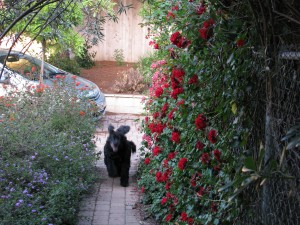
Entranceway with Running Dog April and May are months that I often don’t remember when reflecting back at the end of the year. Spring is such a busy season. When I was raising children, and when I was working as a school librarian, these months rushed past in the haste towards summer break. As a gardener, Spring is one season when I turn into one of those Garden Designers London and since it is also the season of intense growth of both weeds and desirables, insects and increasing dryness, and for me and so many others, the inevitable allergies that keep me out of the garden for days. So I thought I’d post photos of my gardens as they stand today, in the middle of April, on threshold of Summer.

By the Front Door I’ll start at my front door and work downhill. The walkway to the front door is lined with purple lantana and a mixture of red geraniums, honeysuckle, butterfly bush and Double Delight rose. It is being enjoyed by my very silly old dog General Mischief, who just realized that I was going to let him into the house. He looks a bit like a vampire dog in this photo, though!
By my front door I have a collection of miscellaneous plants, as most people do. Two staghorn ferns given me by my mother have attached themselves in a very satisfactory way to the chain link fence. There is also a dark red ivy geranium, needlepoint ivy, some bulbs just out of bloom, a traveling (or Egyptian) onion (it’s seeds are bulbets grown on the flower) that my brother gave to me, and some sedums. When I water here I usually disturb a Pacific Chorus Frog or two. I’ve thinned and weeded and replanted this collection, but there are always more that magically appear.
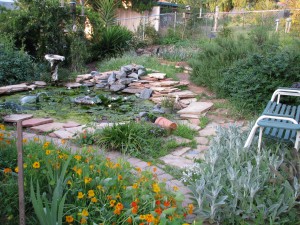
Front Pond The front yard pond is full of algae, but that is all right for the moment. I don’t want a crystal clear pond; I want habitat. Because of the clear blobs of frog spawn and wriggling tadpoles hiding from the hungry mouths of the mosquito fish I keep the algae until it is no longer inhabited. Waterlilies (even the monster one! Look at other posts for an explaination) are blooming with last weekend’s sudden heat. In the foreground are Jewel Mix nasturiums with heirloom tuberoses emerging, a grey mound of lamb’s ear which has begun to pop up where I don’t expect it, and rosemary by the bird feeders. Our kitchen table has the view of the feeders, and it is from this yard that we count birds seasonally for Cornell University’s Project Feederwatch. Oh, and try not to focus on the weeds, please.
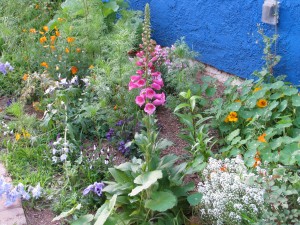
Side Gardens On the South side of my house I’ve painted the wall a Mediterranean blue to reduce the glare and create a colorful backdrop for flowers. I keep annuals in this bed, along with some bulbs and a rose that is still small that my daughter gave to me. In th photo just blooming are naturtium, alyssum, foxglove, pansies, and a delphinium that fell over and started growing upright again. My library window overlooks this yard. I was trying to keep the color scheme focusing on apricot to show up well agains the wall, but I end up planting whatever I want in here. Cosmos have again reseeded and are starting to grow rapidly; they’ll block the window by summer and be full of goldfinches. I’ve also planted a couple of bleeding hearts that I picked up in one of those bulb packages at WalMart. Usually the plant is pretty spent and they aren’t worth the money, but I somehow think that I am rescuing the poor thing. These came up but haven’t yet bloomed.
Lady Banksia Along my driveway is a Lady Banksia rose that has taken off, along with a bush mallow, a Hidcote lavender, and a late daffodil. Farther along the driveway (not shown) is a Pride of Madera (I love that name!) that is going gangbusters, a small liquidamber, rockrose, a mixture of natives and incidental plants such as a tomato that survived the winter, a Joseph’s Coat rose, and an established pine tree with a crow’s nest at the top. There are other roses and plants here, too, like a prostrate pyracantha for berries, a white carpet rose, native milkweed for the Monarch butterflies (perennial ones; the annuals are usually gone by the time the butterflies migrate here), an apricot penstamon, aloe vera, and probably the kitchen sink, too, if I root around long enough. I love tinkering around with this mess of plants, seeing what will grow and trying new combinations.
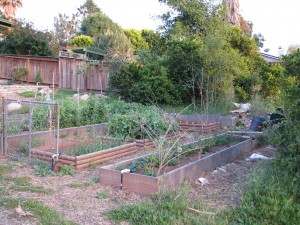
Raised Vegetable Beds In my raised vegetable beds the peas have been producing well. The shorter ones had been nibbled by crows as they were emerging, but after I put a rubber snake amongst them, the nibbling stopped. Potatoes are nearing harvest time, and I’ve already snuck out a few new potatoes and they were very good. Sometimes I’ve had potatoes with brown fiber in them and a bitter taste; no doubt due to irregular watering and soil problems. I worked hard on improving my soil and giving it a boost with natural fertilizers from Gardens Alive. There are so many peas in the garden because I planted all my old packets so that the roots will set nitrogen in the soil.
I also have growing carrots, broccoli, cilantro, parsley, endive, salad mix, parsnip, strawberries, blueberries, breadseed poppies, horseradish, asparagus, bush beans, fava beans, a yellow tomato and a red slicing tomato, garlic, shallots, red and white onions, Swiss chard, leeks, collards and basil. Most are just small guys right now.

Seedlings In my temporary nursery area I have sprouting pickling cucumbers, zucchini, quinoa (first time!), more basil, Dukat dill, cantalope, and a cooking pumpkin. I’ll sprout more squashes and maybe popcorn and sweet corn soon.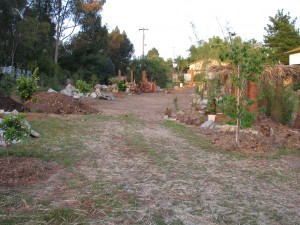
View up the Middle This is a view of the middle of my property, from the lower end up.
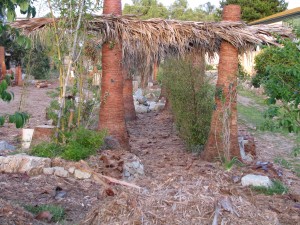
Palm Tree Walkway This is the palm tree walkway as it stands now.

Pre-Pond And this is the lower area. Notice the stakes in the ground and the tractors? They are there because today is the day the ponds will be excavated! The rain-catchment ponds, permanent habitat pond and swales will be carved, shaped and filled in the next two days, fed by water from a 4-inch well augered in the lower property. I have hired Aquascape to create habitat and rain catchment ponds; the demostrations of their work look as if humans hadn’t messed with anything. In about an hour from now, the action finally begins! After the ponds are installed, then the final plant guilds will be established, the minor amount of irrigation installed, and that will be that! I’ll keep you posted on pond development!

